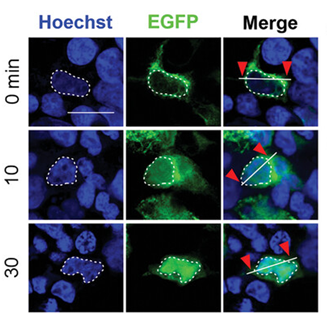

Movement of fluorescent cargo (EGFP, green) from the cytoplasm to the nucleus (Hoechst, blue) as early as 10 minutes after stimulation with hippocalcin
Invention Summary:
Monitoring neuronal differentiation in stem cells is vital to advance regenerative stem cell therapies and our understanding of various neurodegenerative diseases. Traditional techniques (RT-qPCR, Western Blotting, immunofluorescence staining, flow cytometry) are time consuming, involve invasive or destructive measurements, offer limited resolution for monitoring individual cells and are prone to artifacts introduced during sample preparation and analysis.
Rutgers researchers have developed a cell-based biosensor that detects hippocalcin, a key biomarker of neuronal differentiation. This method eliminates the need for cell destruction, offers earlier detection of neuronal differentiation compared to current methods, and is highly selective for neuronal differentiation.
Market Applications:
- Method of monitoring neuronal differentiation
- Prepared HeLa and ReN cell lines
- Research tool
- Precision medicine
Advantages:
- Non-invasive method
- Response time as low as 10 minutes
- Earlier detection than TuJ1
- High sensitivity
- Selective for neuronal differentiation
Publications: • https://doi.org/10.1002/adfm.202400394
Intellectual Property & Development Status: Provisional application filed. Patent pending. Available for licensing and/or research collaboration. For any business development and other collaborative partnerships, contact: marketingbd@research.rutgers.edu